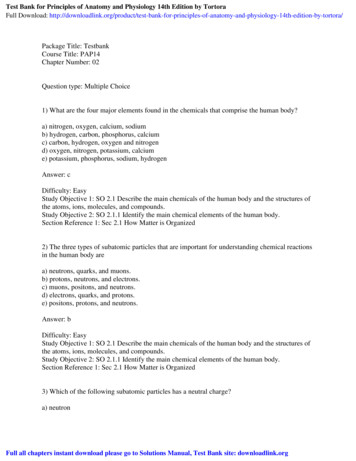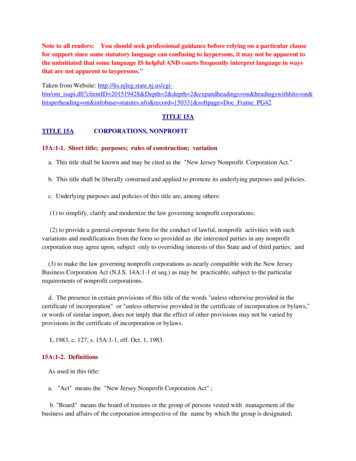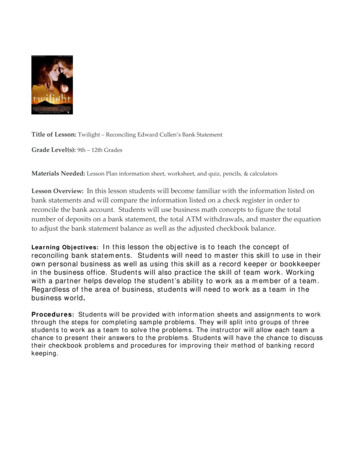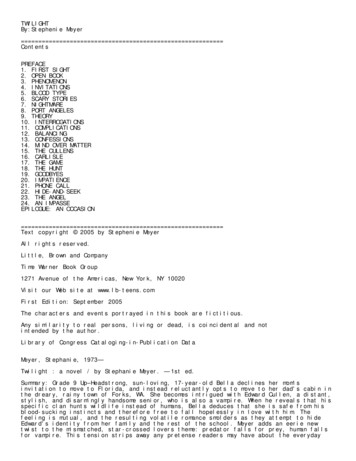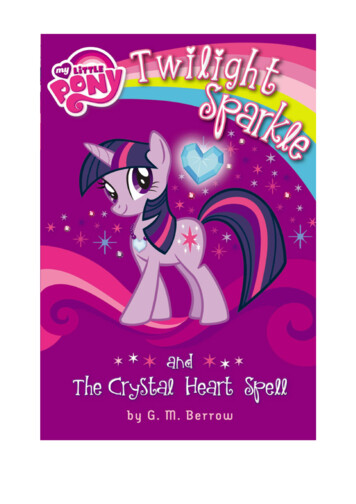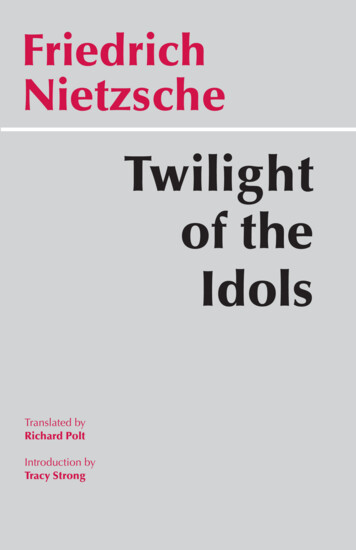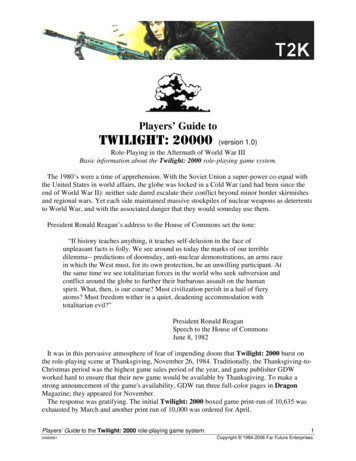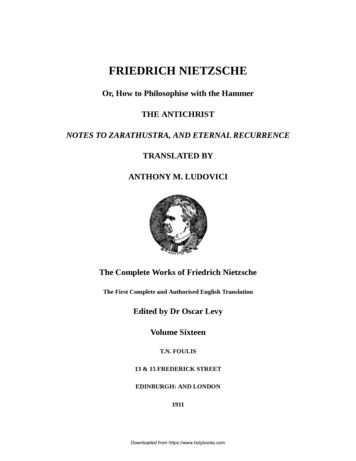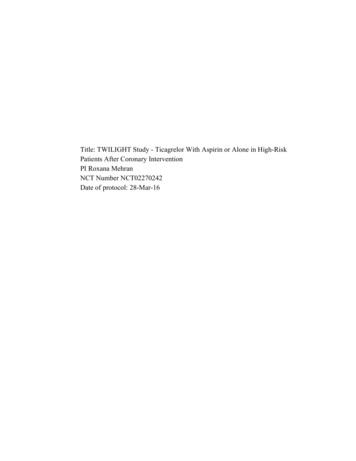
Transcription
Title: TWILIGHT Study - Ticagrelor With Aspirin or Alone in High-RiskPatients After Coronary InterventionPI Roxana MehranNCT Number NCT02270242Date of protocol: 28-Mar-16
Drug SubstanceVersion NumberTicagrelor and 28-Mar-2016Study NumberEudraCT No.ClinicalTrials.gov IDTWILIGHT StudyTicagrelor With Aspirin or Alone in High-Risk Patients After CoronaryInterventionFunding Agency:TITLE PAGEAstraZenecaSponsor-Investigator/Academic Research Center (ARC): The Office of Interventional CardiovascularResearch and Clinical Trials at Icahn School of Medicine atMount SinaiPage 1 of 58
Clinical Study ProtocolDrug SubstanceStudy NumberEdition NumberDateTWILIGHT StudyTicagrelor & AspirinISSBRIL0345Version 4.028-Mar-2016PROTOCOL SYNOPSISTitle of StudyTWLIGHT Study - Ticagrelor With Aspirin or Alone in High-RiskPatients After Coronary InterventionPrimaryInvestigator:Roxana Mehran, MD, FACC, FACP, FCCP, FESC, FAHA, FSCAIStudy Centers:Approximately 100 sites in U.S., Canada, South America, Europe,and ChinaStudy DesignMulticenter, prospective, blinded dual-arm studyPurposesAim 1: To determine the impact of ticagrelor alone versus ticagrelorplus aspirin in reducing clinically relevant bleeding among high-riskpatients who had PCI with at least one drug-eluting stent.Professor of Medicine and Director of Interventional CardiovascularResearch and Clinical TrialsIcahn School of Medicine at Mount SinaiAim 2: To determine the impact of ticagrelor alone versus ticagrelorplus aspirin in reducing ischemic adverse events at one year amonghigh-risk patients undergoing PCI with at least one drug-eluting stent.Enrollment andPatient PopulationUp to 9000 high-risk patients who have undergone successful PCIwith at least one locally approved drug eluting stent discharged onDAPT with aspirin and ticagrelor of at least 3 months intendedduration.Primary ObjectiveThe primary objective of this study is to determine the impact ofantiplatelet monotherapy with ticagrelor alone versus DAPT withticagrelor plus aspirin for 12 months in reducing clinically relevantbleeding among high-risk patients undergoing PCI who havecompleted a 3-month course of aspirin plus ticagrelor.SecondaryObjectivesThe secondary objective of this study is to determine the impact ofantiplatelet monotherapy with ticagrelor alone versus DAPT withticagrelor plus aspirin for 12 months in reducing major ischemicadverse events among high-risk patients undergoing PCI who havecompleted a 3-month course of aspirin plus ticagrelor.Eligibility CriteriaHigh-risk patients who have undergone successful PCI with at leastone locally approved drug eluting stent AND discharged on DAPTwith aspirin and ticagrelor of at least 3 months intended duration willbe eligible for the TWILIGHT study.Page 2 of 58
Clinical Study ProtocolDrug SubstanceStudy NumberEdition NumberDateTWILIGHT StudyTicagrelor & AspirinISSBRIL0345Version 4.028-Mar-2016Enrollment into the study will require meeting at least one clinicalinclusion AND at least one angiographic inclusion AND none of theexclusion criteria.Clinical Inclusion Criteria (MUST MEET AT LEAST ONE):Adult patients 65 years of ageFemale genderTroponin positive acute coronary syndromeEstablished vascular disease defined as previous MI,documented PAD or CAD/PAD revascularization Diabetes mellitus treated with medications (oralhypoglycemic, subcutaneous injection of insulin) Chronic kidney disease defined as an estimated glomerularfiltration rate (eGFR) 60 ml/min/1.73m2 or creatinineclearance (CrCl) 60 ml/minAngiographic Inclusion Criteria (MUST MEET AT LEAST ONE): Multivessel coronary artery diseaseTarget lesion requiring total stent length 30 mmThrombotic target lesion(s)Bifurcation lesions with Medina X,1,1 classification requiringat least 2 stents Left main ( 50%) or proximal LAD ( 70%) lesion Calcified target lesion(s) requiring atherectomyExclusion Criteria: Under 18 years of ageContraindication to aspirin (listed in appendix D)Contraindication to ticagrelor (listed in appendix E)Planned surgery within 90 daysPlanned coronary revascularization (surgical or percutaneous)within 90 daysNeed for chronic oral anticoagulationPrior strokeDialysis-dependent renal failureActive bleeding or extreme-risk for major bleeding (e.g. acutegastrointestinal ulcer or history of chronic gastrointestinalulceration, gastrointestinal pathology with a raised risk forbleeding, malignancies with a raised risk for bleeding)Salvage PCI or STEMI presentation.Liver cirrhosisLife expectancy 1 yearUnable or unwilling to provide informed consentWomen of child bearing potential (as defined in Section 4.2)Page 3 of 58
Clinical Study ProtocolDrug SubstanceStudy NumberEdition NumberDateTWILIGHT StudyTicagrelor & AspirinISSBRIL0345Version 4.028-Mar-2016Fibrinolytic therapy within 24 hours of index PCIConcomitant therapy with a strong cytochrome P-450 3Ainhibitor or inducer Platelet count 100,000 mm3 Requiring ongoing treatment with aspirin 325 mg dailyThe eligibility for randomization for all enrolled subjects will beevaluated at the in-person 3-month study visit. Subjects with any ofthe following will not be randomized: Refusal of randomization by subject or treating physician Withdrawal of consent Lost to follow-up Death Major bleeding (BARC Types 3b or greater) Occurrence of an ischemic event after PCI such as myocardialinfarction, definite or probable stent thrombosis, ischemicstroke, coronary revascularization with drug-eluting stent No longer taking DAPT with aspirin and ticagrelor Non physician-guided cessation of aspirin or ticagrelor of 5consecutive days or greater. Women of child bearing potential (as defined in Section 4.2) Renal failure requiring dialysis Current indication for oral anticoagulation or high doseaspirin RandomizationStatistical MethodsAnalysis forPrimary BleedingEndpointThe analysis for the primary bleeding endpoint will be performed onthe ITT population. The primary objective is to determine ifticagrelor monotherapy is superior to ticagrelor plus aspirin for theprimary bleeding endpoint (BARC Types 2, 3 or 5 bleeding). Thenull hypothesis for this analysis is that the HR for the experimentalgroup (H0) 1. The alternative hypothesis is that the HR for theexperimental group (HA) 1. A test of superiority at the two-sided0.05 level will be performed using a Cox proportional hazard modelthat includes treatment group as a covariate. A point estimate andtwo-sided 95% CI for the relative risk as measured by the hazardratio will be calculated based on the Cox proportional hazards model.Event rates will be estimated at one year and Kaplan-Meier curveswill be plotted for the time from randomization to the first occurrenceof confirmed BARC Type 2, 3 or 5 bleeding by treatment group.This analysis will be repeated in the per protocol (PP) cohort tosupport the primary results.Page 4 of 58
Clinical Study ProtocolDrug SubstanceStudy NumberEdition NumberDateTWILIGHT StudyTicagrelor & AspirinISSBRIL0345Version 4.028-Mar-2016Analysis forPrimary IschemicEndpointThe analysis for the primary ischemic endpoint will be performed onthe PP cohort. The primary objective is to determine if ticagrelormonotherapy is non-inferior to ticagrelor plus aspirin for the primaryischemic endpoint (all-cause death, non-fatal myocardial infarction,or stroke). Event rates will be estimated at one year and KaplanMeier curves will be plotted for the time from randomization to thefirst occurrence of confirmed all-cause death, non-fatal myocardialinfarction, or stroke or by treatment group. A test of non-inferiority atthe one-sided 0.025 level will be performed. . . . Assuming an eventrate of 8.0% in the control group, a sample size of 8200 will yield80% power to exclude an absolute non-inferiority margin of 1.6%. Ifthe upper limit of the 95% CI for the point estimate of the absoluterisk difference between groups is less than or equal to 1.6% then thecriteria for non-inferiority will be met. This non-inferiority margintranslates to a relative risk of 20% assuming the observed event rateequals 8.0% in the control arm.Statistical MethodsUnless otherwise stated, all hypothesis tests will be performed usingtwo-sided tests at the 5% significance level. Continuous variableswill be summarized using descriptive statistics including means andstandard deviations if normally distributed or median withinterquartile ranges for skewed distributions. Discrete variables willbe summarized using absolute and relative frequencies.Sample SizeParametersA cumulative bleeding rate of 4.5% is anticipated between time ofrandomization and 1 year. Assuming a 2% loss to follow-up andnon-compliance / cross-over rate of 4%, the current trial will require8200 subjects to detect a relative reduction in bleeding of 28% withticagrelor monotherapy with 80% power and a Type I error of 0.05.It is anticipated that approximately 8% - 10% of enrolled subjectswill not be eligible for randomization and therefore 9000 subjectswill be enrolled at the time of PCI.Page 5 of 58
Clinical Study ProtocolDrug SubstanceStudy NumberEdition NumberDateTWILIGHT StudyTicagrelor & AspirinISSBRIL0345Version 4.028-Mar-2016Page 6 of 58
Clinical Study ProtocolDrug SubstanceStudy NumberEdition NumberDateTWILIGHT StudyTicagrelor & AspirinISSBRIL0345Version 4.028-Mar-2016TABLE OF CONTENTSPAGETITLE PAGE . 1PROTOCOL SYNOPSIS . 2TABLE OF CONTENTS . 7PROTOCOL SIGNATURE PAGE . 11LIST OF ABBREVIATIONS . 121.INTRODUCTION . 131.1Research hypothesis . 141.2Rationale for conducting this study . 141.3Benefit/risk and ethical assessment. 152.STUDY OBJECTIVES . 152.1Primary objective . 152.2Secondary objective . 162.3Exploratory objectives . 163.STUDY PLAN AND PROCEDURES . 163.1Overall study design and flow chart . 163.2Rationale for study design, doses and control groups . 164.SUBJECT SELECTION CRITERIA . 174.1Inclusion criteria . 174.2Exclusion criteria . 185.5.15.25.35.45.5STUDY CONDUCT . 19Restrictions during the study. 19Subject randomization and initiation of investigational product . 195.2.1Procedures for randomization . 19Procedures for handling subjects incorrectly enrolled or randomized oninvestigational product . 20Blinding and procedures for unblinding the study . 205.4.15.4.2Methods for ensuring blinding . 20Methods for unblinding the study . 21Treatments . 215.5.15.5.2Identity of investigational product . 21Doses and treatment regimens . 21Page 7 of 58
Clinical Study ProtocolDrug SubstanceStudy NumberEdition NumberDate5.5.35.5.45.65.7TWILIGHT StudyTicagrelor & AspirinISSBRIL0345Version 4.028-Mar-2016Additional study drug. 21Labeling . 21Concomitant and post-study treatment . 22Treatment compliance . 225.7.1Accountability . 225.8Discontinuation of investigational product . 225.9Withdrawal from study . 236.6.16.25.8.1COLLECTION OF STUDY VARIABLES . 24Recording of data . 24Data collection at enrollment and follow-up. 246.2.16.2.26.2.36.2.46.37.7.17.27.38.Procedures for discontinuation of a subject from investigational product. 22Enrollment procedures . 27In-person follow-up procedure at 3 months. 27In-person follow-up procedure at 9 and 15 months (for randomizedsubjects) . 28Phone-call follow-up contact at 1, 4 and 18 months post enrollment . 28Efficacy and safety variables . 28SAFETY . 28Definition of adverse events . 28Definitions of serious adverse event . 297.2.1Definition of suspected unexpected serious adverse reactions (SUSARs) . 29Recording of adverse events or serious adverse events . 297.3.17.3.27.3.37.3.47.3.57.3.67.3.7Time period for collection of adverse events . 29Follow-up of unresolved adverse events . 30Information to be collected for each AE/SAE . 30Adverse Events based on signs and symptoms . 31Adverse Events based on examinations and tests . 31Disease progression or pre-existing conditions . 31Reporting of adverse events . 31ETHICAL AND REGULATORY REQUIREMENTS . 328.1Ethical conduct of the study . 328.2Ethics and regulatory review. 328.3Informed consent. 328.4Changes to the protocol and informed consent form . 338.5Deviations from protocol . 348.5.18.5.28.5.3Compliance to protocol . 34Procedures for recording, reporting, and analyzing protocol deviations . 34Corrective and preventative actions and principal investigatordisqualification criteria . 34Page 8 of 58
Clinical Study ProtocolDrug SubstanceStudy NumberEdition NumberDate8.69.TWILIGHT StudyTicagrelor & AspirinISSBRIL0345Version 4.028-Mar-2016Audits and inspections . 34STUDY MANAGEMENT . 359.1Training . 359.1.19.1.29.2Training of Monitors . 35Training of study site research personnel . 35Monitoring of the study. 359.2.19.3Source data . 36Study timetable and end of study . 3710.DATA MANAGEMENT . 3711.EVALUATION AND CALCULATION OF VARIABLES . 3712.STATISTICAL METHODS AND SAMPLE SIZE DETERMINATION . 3811.1.111.1.211.1.311.1.412.1Primary Bleeding Endpoint . 37Secondary Bleeding Endpoints . 37Primary Ischemic Endpoint . 38Secondary Ischemic Endpoints . 38Description of analysis sets . 3812.1.112.1.2Efficacy analysis set . 39Safety analysis set . 3912.2Methods of statistical analyses . 3912.3Determination of sample size . 4112.4Data and safety monitoring board . 4213.IMPORTANT MEDICAL PROCEDURES TO BE FOLLOWED BY THEINVESTIGATOR. 4313.1Overdose . 4313.2Pregnancy . 4314.LIST OF REFERENCES . 4415.APPENDIX A – DEFINITIONS FOR STUDY ENDPOINTS . 4815.1Bleeding events . 4815.1.115.1.215.1.315.1.415.2Bleeding Academic Research Consortium definition of bleeding . 48Thrombolysis in Myocardial Infarction definition of bleeding . 49Global Utilization of Streptokinase and TPA for Occluded Arteries(GUSTO) definition of bleeding . 51International Society on Thrombosis and Haemostasis definition ofbleeding. 51Major Adverse Cardiovascular Events . 5215.2.115.2.215.2.315.2.4Death. 52Myocardial Infarction . 52Stroke . 54Stent thrombosis. 54Page 9 of 58
Clinical Study ProtocolDrug SubstanceStudy NumberEdition NumberDate15.2.5TWILIGHT StudyTicagrelor & AspirinISSBRIL0345Version 4.028-Mar-2016Clinically driven revascularization. 5516.APPENDIX B - OTHER DEFINITIONS . 5617APPENDIX C – Flowchart of In-Person Visits And Phone Calls .6118.APPENDIX D – CONTRAINDICATION TO ASPIRIN . 6119.APPENDIX E – CONTRAINDICAITON TO TICAGRELOR . .62LIST OF TABLESTable 1Identity of Investigational Product . 21Table 2Schedule of Data Collection . 26Table 3Bleeding Rates/Effect Sizes for Primary Endpoint PowerCalculations . 41Table 4Power and Sample Size Scenarios for Primary SuperiorityEndpoint of BARC 2 Bleeding . 42Table 5Sample Size/Poser Calculations for Non-inferiority MACEComparison between Groups at 1 Year . 49Table 6BARC Bleeding Definition, modified from Mehran et al (22) . 48Table 7TIMI Bleeding Definition(23) . 49Table 8GUSTO Bleeding Definition (24) . 51Table 9Classification of Death(25) . 52Table 10Timing of Stent Thrombosis . 55Page 10 of 58
Clinical Study ProtocolDrug SubstanceStudy NumberEdition NumberDateTWILIGHT StudyTicagrelor & AspirinISSBRIL0345Version 4.028-Mar-2016PROTOCOL SIGNATURE PAGEI have read this clinical investigation plan and appendices and agree to adhere to therequirements. I will provide copies of this clinical investigation plan and all pertinentinformation to the trial personnel under my supervision. I will discuss this material with themand ensure they are fully informed regarding the study drugs and the conduct of the trial.I will conduct the trial in accordance with the clinical investigation plan, Good ClinicalPractice guidelines, World Medical Association Declaration of Helsinki: Ethical Principles forMedical Research Involving Human Subjects, as well as local regulations. I also acceptrespective revisions to the clinical investigation plan approved by authorized personnel of theARCC and by regulatory authorities.This document contains proprietary and confidential information of AstraZeneca and theMount Sinai Academic Research Center. Do not copy, distribute, or share with others withoutprior written authorization from AstraZeneca and the Mount Sinai Academic ResearchCenter.Investigator Name (print)Investigator Name (signature)DateInstitution Name (print)Page 11 of 58
Clinical Study ProtocolDrug SubstanceStudy NumberEdition NumberDateTWILIGHT StudyTicagrelor & AspirinISSBRIL0345Version 4.028-Mar-2016LIST OF ABBREVIATIONSThe following abbreviations and special terms are used in this Clinical Study Protocol.Abbreviation orspecial 2Adverse EventAcademic Research CenterAcetylsalicylic Acid (Aspirin)Body Mass IndexBare Metal StentCoronary Artery DiseaseClinical Events CommitteeCase Report FormDual Antiplatelet TherapyDrug Eluting StentData Safety Monitoring BoardEthics CommitteeFood and Drug Administration (U.S.)Fractional Flow ReserveInformed Consent FormInvestigational New Drug Application (FDA)Institutional Review BoardInvestigator Sponsored StudyIntention-to-Treat (analysis dataset)Intravascular UltrasoundInteractive Voice/Web Response SystemLeft Anterior Descending (Coronary Artery)Myocardial InfarctionNon-Steroidal Anti-Inflammatory DrugNon ST Elevation Myocardial InfarctionThe P2Y₁₂ protein is found mainly but not exclusively on the surfaceof blood platelets, and is an important regulator in blood clotting.Peripheral Artery DiseasePercutaneous Coronary InterventionPer Protocol (analysis dataset)Serious Adverse EventST Elevation Myocardial InfarctionPADPCIPPSAESTEMIPage 12 of 58
Clinical Study ProtocolDrug SubstanceStudy NumberEdition NumberDateTWILIGHT StudyTicagrelor & AspirinISSBRIL0345Version 4.028-Mar-2016The following abbreviations and special terms describe other clinical protocols or academicbodies.Abbreviation orspecial termExplanationBARCEXCELLENTBleeding Academic Research ConsortiumTrial Name: Efficacy of Xience/Promus versus Cypher in ReducingLate Loss after StentingTrial Name: Global Utilization of Streptokinase and TPA forOccluded ArteriesTrial Name: Optimized Duration of Clopidogrel Therapy followingTreatment with the Endeavor Zotarolimus-Eluting Stent in the RealWorld Clinical PracticeTrial Name: Platelet Inhibition and Patient Outcomes TrialTrial Name: Synergy between Stent and Drugs to Avoid IschemicRecurrences after Percutaneous Coronary InterventionTrial Name: TAXUS Drug-Eluting Stent versus Coronary ArteryBypass Surgery for the Treatment of Narrowed ArteriesTrial Name: Thrombolysis in Myocardial RODUCTIONPharmacologic platelet inhibition with aspirin and a P2Y12 inhibitor is a requirement in allpatients undergoing percutaneous coronary intervention (PCI) with stenting. Such dualantiplatelet therapy (DAPT) is recommended by international guidelines, with durationvarying according to clinical presentation (i.e. acute coronary syndrome) or type of stentimplanted during PCI (bare metal vs. drug eluting)(1-3). The paradigm for DAPT is shifting toshorter durations, as evidenced by most recent ESC /EACTS Guidelines on myocardialrevascularization giving a class Ib recommendation for 6 months of DAPT after DES(4).While clopidogrel is the most widely used P2Y12 inhibitor, its efficacy is hampered bysubstantial variability in platelet inhibition that may be attributable to clinical, genetic andprocedural parameters (5-8). Moreover, although the novel thienopyridine prasugrel has amore potent and consistent effect on platelet inhibition (9, 10), bleeding risk is significantlyhigher compared to clopidogrel in acute coronary syndrome (ACS) patients following PCI(11). In contrast, ticagrelor, an oral, reversible, direct-acting inhibitor of the adenosinediphosphate P2Y12 receptor (12) has proven faster, greater and more consistent P2Y12inhibition than either clopidogrel or prasugrel (13-15). In the landmark Study of PlateletInhibition and Patient Outcomes (PLATO) trial, ticagrelor significantly reduced death fromvascular causes, myocardial infarction, or stroke, without significantly increasing overallmajor bleeding in patients presenting with acute coronary syndromes (16).Along with the advent of more potent antiplatelet pharmacotherapy, stent technology has alsoadvanced in a concordant fashion with the introduction of safer and less thrombogenicPage 13 of 58
Clinical Study ProtocolDrug SubstanceStudy NumberEdition NumberDateTWILIGHT StudyTicagrelor & AspirinISSBRIL0345Version 4.028-Mar-2016platforms. These devices, compared to their older-generation counterparts, yield significantreductions in thrombotic events that are durable over the long term (17). As a consequence,classical paradigms favoring a minimum of DAPT duration of 1 year, particularly in electivepatients, are being challenged as PCI safety continues to evolve and improve. Randomizedcomparisons of different DAPT durations such as the OPTIMIZE and the PRODIGY trialssuggest no increased risk for thrombotic events after only 3-6 months of DAPT in PCI patientstreated primarily with novel generation devices (18-22).1.1Research hypothesisThe overall hypothesis of the current study is that three months post-PCI of dual antiplatelettherapy with aspirin and ticagrelor, continued monotherapy with ticagrelor alone versusticagrelor plus aspirin for an additional year will be superior with respect to bleeding and noninferior with respec
Page 1 of 58 Drug Substance Ticagrelor and Aspirin Study Number ISSBRIL0345 EudraCT No. 2014-005498-35 ClinicalTrials.gov ID NCT02270242 Version Number 4.0 Date 28-Mar-2016 TWILIGHT Study Ticagrelor W
